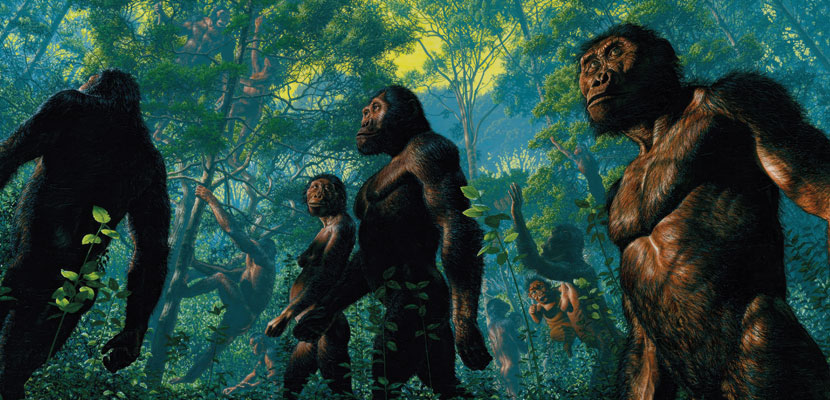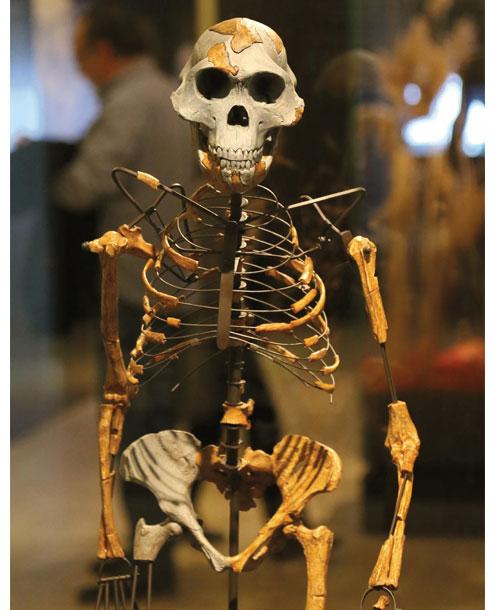Paleo-anthropology’s Superstar
By Bernard Anthony Wood
Fifty years after the discovery of the fossilized skeleton nicknamed “Lucy,” the hominin continues to inspire research into human origins.
Fifty years after the discovery of the fossilized skeleton nicknamed “Lucy,” the hominin continues to inspire research into human origins.

”Lucy” is the now-famous moniker given 50 years ago to a fragmentary early hominin skeleton recovered from a hillside in the Horn of Africa. The fossilized remains of a diminutive female hominin were first spotted by Tom Gray, then a graduate student member of an American and French team that in the early 1970s was searching outcrops dating to 3 to 4 million years old near Hadar, Ethiopia, for evidence of human ancestors. A few years later, Lucy, along with the other early hominins recovered from Hadar and from Laetoli in Tanzania, was assigned to a novel species, Australopithecus afarensis, by Donald Johanson, founding director of the Institute of Human Origins, Tim D. White, now at the University of California, Berkeley, and the late Yves Coppens, who had been a professor at the Collège de France.

John Gurche
Why does the Lucy skeleton play such an outsized role in the public perception of human origins, and where does it fit in our current understanding of human evolutionary history?
The formal label for Lucy is A.L. 288-1: A.L. stands for Afar Locality and 288 indicates it was that number in the order of fossils recovered and logged by the project. But A.L. 288-1 was not the first early hominin fossil to be recovered in Africa. That distinction belongs to a juvenile skull uncovered by miners at the Buxton Limeworks in Taung, South Africa, in 1924. Nor was Lucy the first early hominin found in eastern Africa, or even the first hominin to be found at the Hadar site. Nor is Lucy’s preservation anything special; several better-preserved hominin fossils have been found.
No, what makes A.L. 288-1 scientifically exceptional is that it almost certainly preserves the skull, teeth, torso, and limb bones of a single individual. You can count on one hand the number of decent skeletons of individuals in the fossil record with that level of completeness. Lucy is among the most complete early-hominin fossils in terms of the numbers of bones preserved, even if the quality of their preservation leaves something to be desired.
The relative length of the limbs (or limb proportions) is one of the major differences between modern humans and our closest living relatives, chimpanzees and bonobos. Modern humans have long legs and short arms, whereas chimpanzees have long arms and short legs. But it is hard to get a sense of an early hominin species’ limb proportions when much of the evidence comes from different individuals.
The good news is that we have pieces of nearly all of Lucy’s six long bones; the bad news is that the missing parts make estimating the maximum length of each limb and its segments (the arm/forearm and thigh/leg) a scientific guessing game. Still, enough of each long bone is preserved to suggest that Lucy’s limb proportions were closer to those of chimpanzees than modern humans. Yet Lucy likely did not move around like a chimpanzee; other fossils assigned to A. afarensis provide compelling evidence that the species was an upright biped, though one that practiced a form of bipedal locomotion that differs in significant ways from modern human bipedalism. Lucy and others of her species would have struggled to walk long distances, but they were probably much better than we are at escaping predators by climbing the nearest tree.

Lanmas / Alamy Stock Photo
Giving fossils that belonged to individuals that lived millions of years ago contemporary names makes me uncomfortable, but it was a stroke of marketing brilliance on Johanson’s part to name the newly discovered partial skeleton after the song “Lucy in the Sky with Diamonds” by the Beatles. As far as nonspecialists are concerned, Johanson is the paleoanthropological equivalent of a rock star, and in terms of Lucy’s influence on fundraising, we will never know how many graduate students and field seasons were funded because donors thought there was the prospect—as unlikely as it has proved to be—of finding another fossil like Lucy. Subsequent field research at Hadar led by the late William H. (Bill) Kimbel from Arizona State University attracted much less public interest. But without question, the fossils Kimbel and his colleagues collected over the decades make A. afarensis one of the best sampled early hominin species, and together all of those fossils make a much more substantial scientific contribution than Lucy.
Every early hominin fossil has value; even half a tooth can be distinctive enough to expand the temporal and geographical range of an early hominin species. But Lucy has drawn attention to paleosciences in Ethiopia and attracted more influential scholars to paleoanthropology in that country than is the case in other African countries. Paleoanthropologists Zeray Alemseged at the University of Chicago and Yohannes Haile-Selassie at Arizona State University have each conducted highly productive field research at different locations in Ethiopia, amplifying Lucy’s influence in the half-century since her discovery.
So what is the place of Lucy and her ilk in human evolutionary history? In the 1970s, human evolution was conceived of as being ladderlike: With one or two exceptions, fossil hominin species were considered to be rungs on a ladder that connected a common ancestor to modern humans. The species at the bottom of the ladder were more apelike, whereas the ones near the top were more like modern humans. We now know human evolutionary history is a lot more complicated and nonlinear; a better analogy is a bush. Only one stem of that bush has managed to survive to the present, and that is us, modern humans.
There is reason to think that A. afarensis is a good candidate to be an ancestor of modern humans, but I’m not yet convinced. Lucy’s legacies of fieldwork may provide the required evidence, one way or another, in the coming years.
Click "American Scientist" to access home page
American Scientist Comments and Discussion
To discuss our articles or comment on them, please share them and tag American Scientist on social media platforms. Here are links to our profiles on Twitter, Facebook, and LinkedIn.
If we re-share your post, we will moderate comments/discussion following our comments policy.